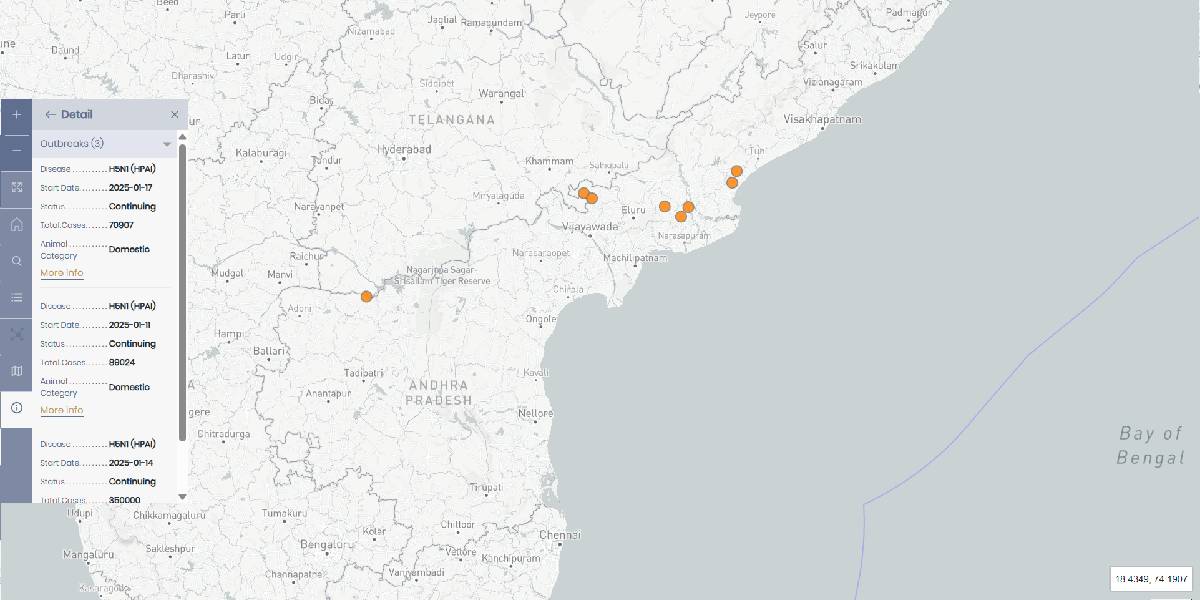The outbreak, first detected in early January 2025, has rapidly spread across poultry farms and backyard poultry units, raising serious concerns among poultry farmers.
Published Mar 30, 2025 | 7:00 AM ⚊ Updated Mar 30, 2025 | 7:00 AM

Multiple Bird Flu outbreak locations in Andhra Pradesh. (World Organisation for Animal Health)
Synopsis: A severe H5N1 avian influenza outbreak in Andhra Pradesh has led to the death and culling of over 5.4 lakh birds, primarily affecting large poultry farms and backyard units. The outbreak, which began in January 2025, has prompted strict control measures, including quarantines and culling. No human infections have been reported, but economic losses in the poultry sector are significant.
A severe outbreak of highly pathogenic avian influenza (H5N1) has been reported across multiple districts of Andhra Pradesh, leading to the deaths and culling of over 5.4 lakh birds.
On March 27, the World Organisation for Animal Health declared the outbreak in Andhra Pradesh as “High Pathogenicity,” originating from a farm in East Godavari’s coastal region and spreading to a backyard poultry unit in Kurnool, Rayalaseema.
The outbreak, first detected in early January 2025, has rapidly spread across poultry farms and backyard poultry units, raising serious concerns among poultry farmers.
According to an official notification from the World Animal Health Information System (WAHIS), the outbreak has resulted in 5,37,606 reported cases, with 3,62,532 birds succumbing to the virus. In an effort to contain the spread, an additional 1,78,050 birds have been culled and disposed of as part of containment measures in Andhra Pradesh.
The outbreak has been classified as a recurrence of an eradicated disease, with the last known occurrence reported in September 2024. The latest confirmation of the virus was recorded on 9 February 2025, with cases continuing to emerge. The primary source of infection remains unknown.
The affected areas span multiple districts, with large-scale poultry farms as well as smaller backyard poultry units reporting cases.
The virus has been confirmed through real-time reverse transcription polymerase chain reaction (rRT-PCR) tests conducted at the National Institute of High Security Animal Diseases (NIHSAD), Bhopal.
11 January 2025: A major outbreak occurred in Kanuru Agraharam, Peravali Mandal, where a poultry farm reported 92,000 cases. Of these, 89,024 birds died, while 2,976 were culled to contain the virus.
14 January 2025: Another one of the largest outbreaks occurred in Badampudi, Ungutur Mandal, Eluru, where a farm with 500,000 susceptible birds registered 350,000 cases. A staggering 204,643 birds died, while 145,357 were culled in an attempt to contain the spread.
17 January 2025: In one of the most severely affected areas, a poultry farm in Velpuru, Tanuku, recorded 70,907 cases, with 49,000 bird deaths. An additional 21,907 birds were culled as a precautionary measure.
4 February 2025: A backyard poultry unit in NR Pet, Kurnool, recorded 25 cases of bird flu in ducks. Among them, 15 birds died, while 10 were culled. Although a smaller outbreak compared to large commercial farms, this case highlights the virus’s ability to affect smaller poultry units as well.
11 February 2025: In Anumolulanka, Gumpalagudem, Krishna district, a farm recorded 14,500 cases, with 7,000 bird deaths. Another 7,500 birds were culled as a preventive measure.
12 February 2025: In Pithapuram Urban, Ward 21, Kakinada, a poultry farm registered 2,000 cases. All affected birds died, but authorities managed to prevent further spread.
14 February 2025: In Chendurthy, Gollaprolu, Kakinada, an outbreak led to the deaths of 8,000 birds, all of which perished due to the infection.
19 February 2025: A smaller yet significant outbreak was noted in Deeplanagar Village, Krishnaraopalem, where 3,150 cases were recorded. Of these, 2,850 birds died, and 300 were culled.
In response to the outbreak, strict biosecurity measures have been enforced in affected areas. Authorities have implemented quarantine zones, movement restrictions, and mass culling efforts.
Disinfection and surveillance activities are ongoing within the restricted zones, while screenings are being conducted outside these areas to monitor potential new cases.
Stamping-out operations, a widely used control measure in avian influenza outbreaks, have been carried out extensively. The disposal of carcasses, by-products, and waste has been conducted under official supervision to prevent further contamination.
The avian influenza outbreak has raised significant concerns for poultry farmers and the broader agricultural sector in Andhra Pradesh. The economic impact is expected to be substantial, given the high mortality rates and the large-scale culling of poultry. Many people across the state and in the neighbouring states of Tamil Nadu and Telangana have stopped buying the chicken.
While the outbreak remains confined to poultry populations, health officials are closely monitoring for any potential spillover into humans, as H5N1 is known to pose zoonotic risks.
As the situation unfolds, authorities and veterinary experts remain vigilant. They hope to bring the outbreak under control before it inflicts further damage to the poultry industry in Andhra Pradesh.
On 19 February, Animal Husbandry Director T Damodar Naidu addressed the situation. He noted, “government implementations, in accordance with India’s biosecurity regulations, have been effective in controlling the spread of bird flu. No new cases have emerged in other areas, and no human infections have been reported so far.”
Dr Naidu also highlighted concerns about misinformation regarding the disease, stating that “some media outlets have contributed to unnecessary panic.”
He reassured the public that veterinarians and medical health staff have consistently emphasized the low probability of bird flu spreading to humans. However, due to misleading reports, both consumers and those dependent on the poultry industry have suffered economic losses.
Furthermore, Dr Naidu urged poultry farmers to report any restrictions on the transport of chickens or eggs. He provided contact details for assistance, directing affected individuals to reach out to the nearest veterinary officer or contact the Animal Husbandry Department’s call center at 0866-2472543 or 9491168699.
(Edited by Sumavarsha)
